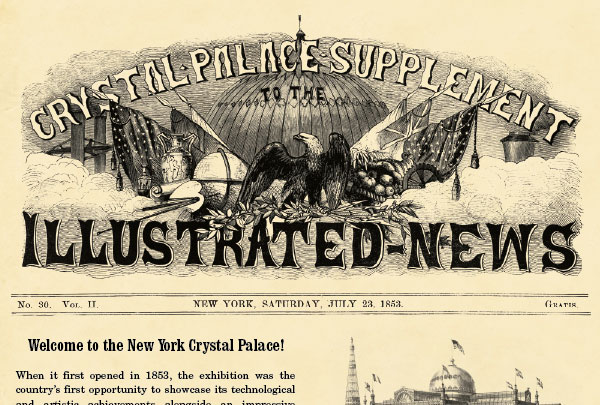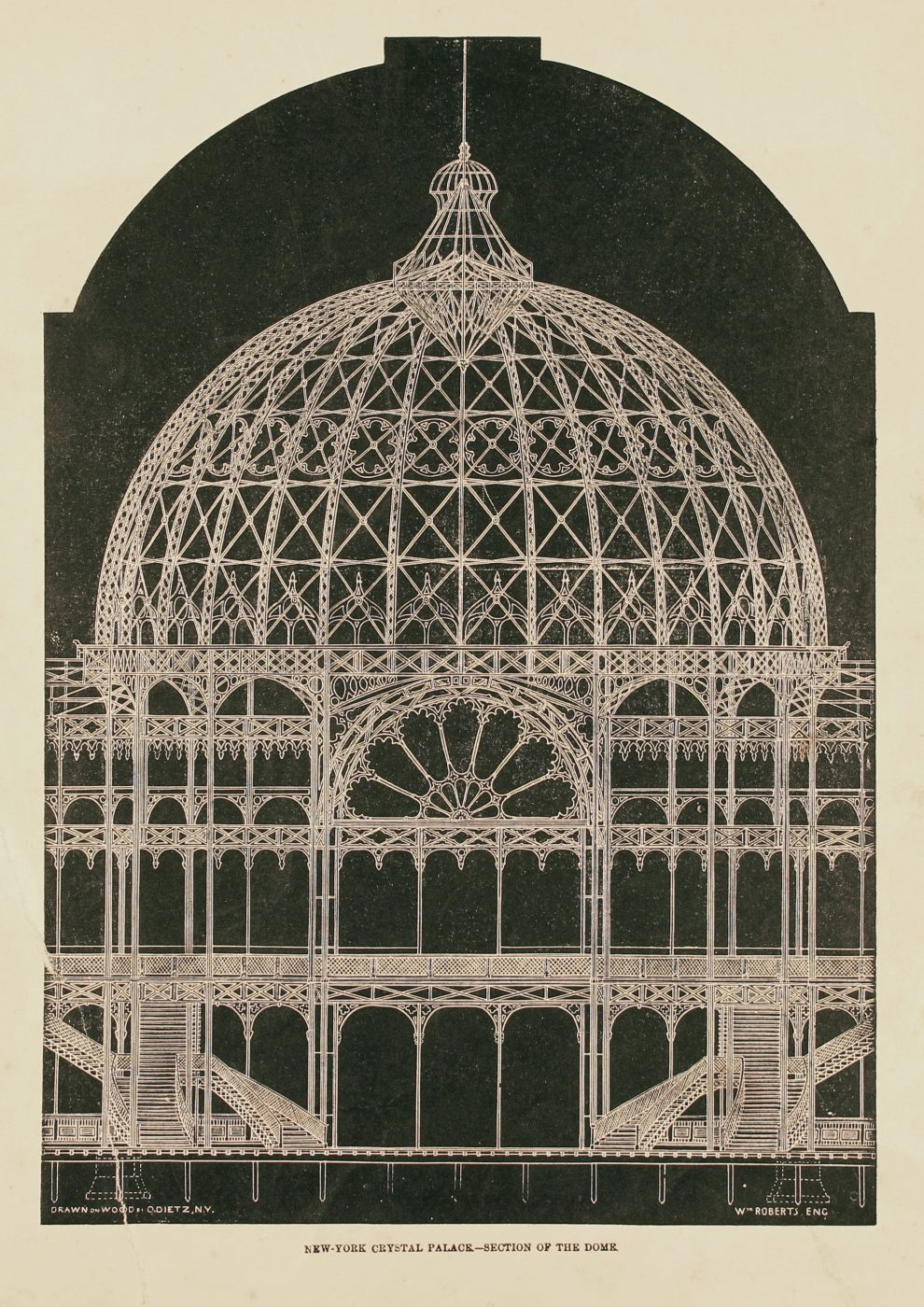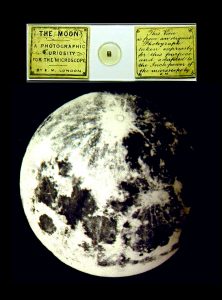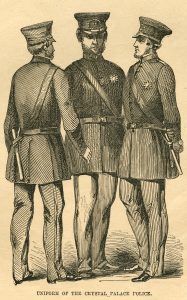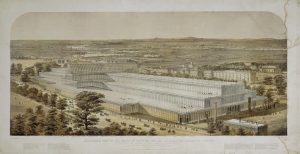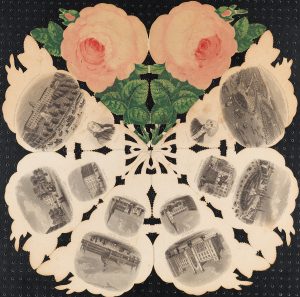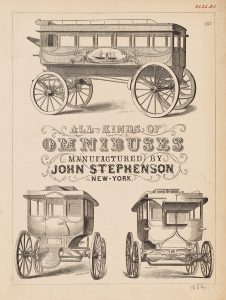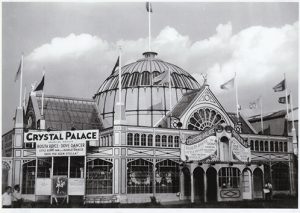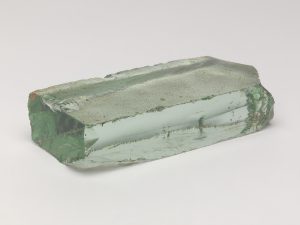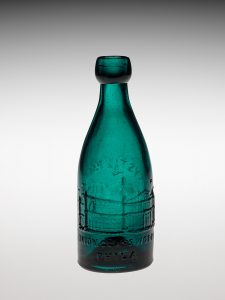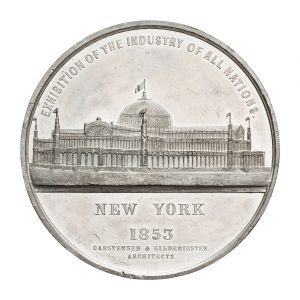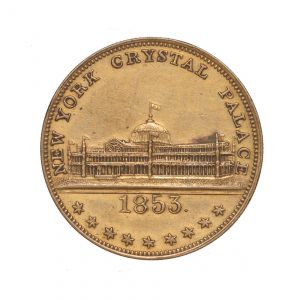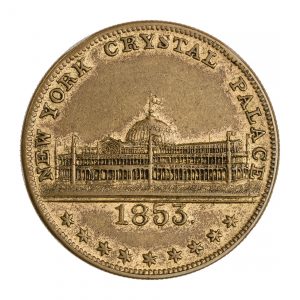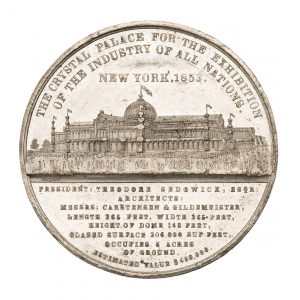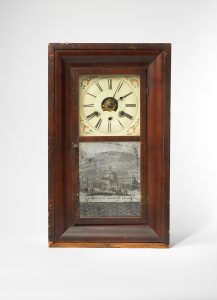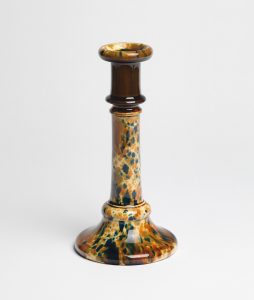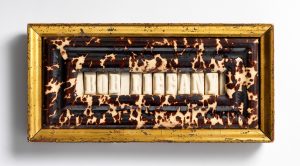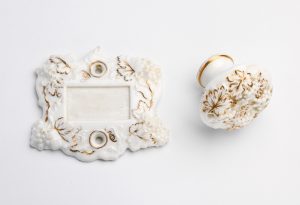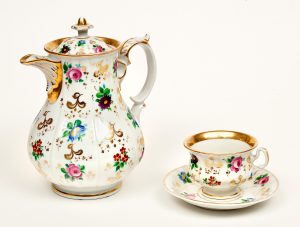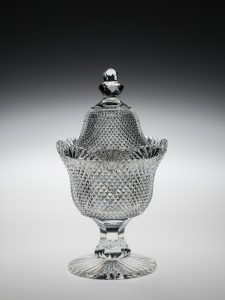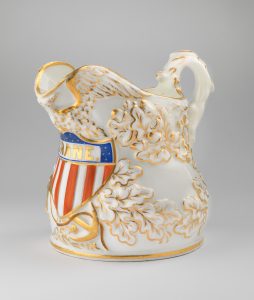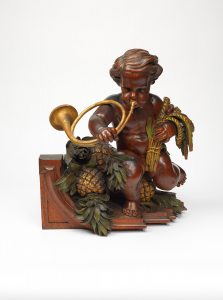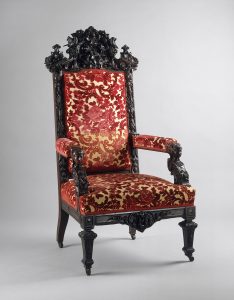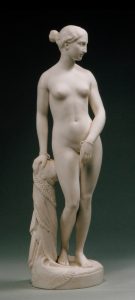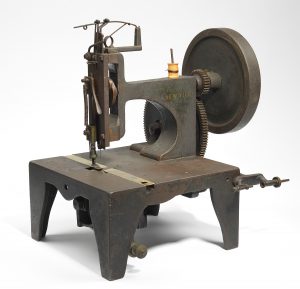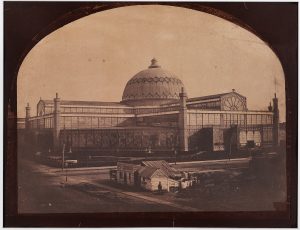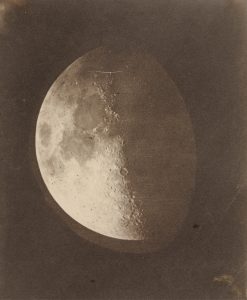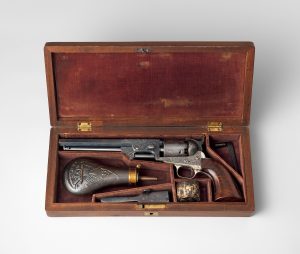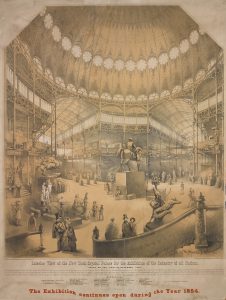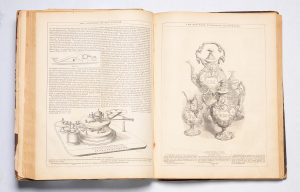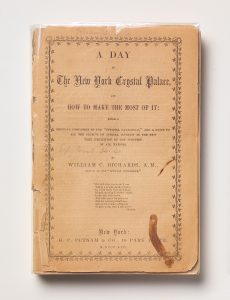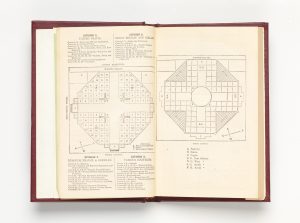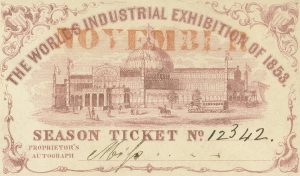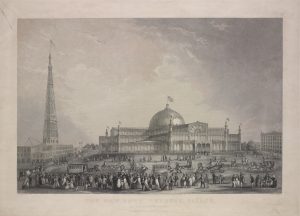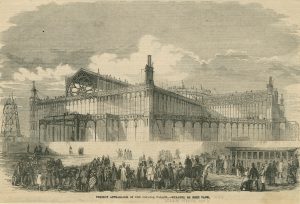The Crystal Eye: The Collimation of Science and Aesthetics Through a Nineteenth-Century Lens
Alexandra Beuscher
In the nineteenth century, the eye was the key to understanding the scale and structure of the universe: Man was God’s masterpiece, and the eye was the apparatus that allowed humanity to witness the beauty and complexity of his creation.1 A fascination with light and optics infused all aspects of science and culture, from philosophical and theological debate, scientific and medical advances, art and architecture, to social conventions and popular culture. The New York Crystal Palace exhibition, with its grand mission of progress and social improvement, encompassed all of these cultural elements. Photography, microscopy, and lighthouse technology were subjects of some of the most popular displays at the exhibition, and offer a window into visual experience in the nineteenth century.
Photography
Of all the advances in optical technology in this period, the invention of the daguerreotype camera had perhaps the greatest impact. Never before had such exact reproductions of the human visual experience been captured in a still image. The new medium was eagerly adopted by artists and also by scientists, who believed that photographs were not susceptible to the same human subjectivity and error inherent in likenesses rendered by hand.2 Photographs represented the truth. Photography was “nature drawing her own picture,” and light was “nature’s pencil.”3
One of the first scientific applications of photographic technology was in astronomy. The discovery that sunlight reacts with photosensitive chemicals to create images was extended to other luminous celestial bodies, and astronomers began to dream of a complete and fully accurate star map: a printed mirror of the sky. John Adams Whipple was one of the first photographers who had success in producing photographs of the nearest celestial body, Earth’s moon. In 1851, working with astronomers at the Harvard observatory, he combined a telescopic lens and a camera lens to produce what was referred to as the moon’s “self portrait,” drawn in her very own light.4
Figure 1 shows Whipple’s salt print photograph of the moon, an early reproduction of his original daguerreotype that was displayed at the New York Crystal Palace, and won a silver medal.5 It was grouped in a category called “Philosophical Instruments and Products Resulting from Their Use,” a title reflective of the ambiguous status of optical instruments and photographs in this period. Photographs were somewhere between artistic and scientific creations, and light and vision were matters of philosophy or theology. In fact, the human eye was often cited as evidence for the existence of God because the eye is so perfectly designed for its purpose that it must have been created by an intelligent being.6 Within this framework, optical instruments such as cameras were tools for assessing man’s place in God’s universe. Perhaps this is why some of the first applications for optical technologies sought to explore the heavens.7

Fig. 1John Adams Whipple. The Moon, 1853–54. Salted paper print. The Museum of Modern Art, Gift of Warner Communications, Inc., 1195. 1979. Digital Image © The Museum of Modern Art / Licensed by SCALA / Art Resource, NY.
Microscopy
The burgeoning field of microscopy also sought to explore the unknown universe, though on a reverse scale. The first half of the nineteenth century saw great improvements in microscope design and functionality. Achromatic lens technology was perfected, bringing multiple wavelengths of light into focus and eliminating distortion in the resulting image. New fields such as microbiology were created for the study of these invisible worlds, which were evidently teeming with new life forms.8
One of the first microscope manufacturers in the United States, J. & W. Grunow and Co., displayed four microscopes at the New York Crystal Palace. They were awarded second place for their display, which included an innovative binocular microscope for professional scientific use.9 They also made smaller “educational microscopes” for students and hobbyists. A description of the instrument from their catalogue reads: “This microscope is designed . . . for educational purposes, for schools, private families, and for young people generally. Farmers, mechanics and merchants, who desire to devote some of their leisure hours to intellectual improvement . . . will find this at once a cheap, substantial, and efficient microscope.”10
By 1850, microscopy was already a popular hobby among upper-class Victorian families in Europe. Many fine homes had a microscope in the parlor, along with a set of slides for recreational viewing. These sets often included curiosity slides made for amusement. Figure 2 shows a slide featuring a microphotograph of the moon. The original photograph must have been taken with the aid of a telescope similar to John Whipple’s, yet a microscope is needed to see the subject’s astronomical proportions. These games of scale reveal the nineteenth-century delight in manipulating the universe, reducing astronomical bodies to a state invisible to the naked eye, then further employing lenses to make them visible once again.

Fig. 2 E. M. London. Moon. Microphotograph. Private collection of Howard Lynk.
Nineteenth-century microscopic studies provide wonderful examples of the conflation of scientific and decorative aesthetics in this period. As photography curator Corey Keller writes, “Modern viewers have a certain anxiety when viewing purportedly scientific images that are beautiful. These images are not supposed to evoke an emotional response. They are merely supposed to record data.”11 This, however, was not the case in the nineteenth century.12 Many of the scientific illustrations and photographs in this period, both by professionals and by hobbyists, were meant to have aesthetic interest.
In the later part of the century, a practice emerged in which microscopists would carefully arrange specimens into geometric patterns on microscope slides. There was a particular fascination with diatoms: single cell algae that build complex glasslike silica shells around themselves.13 The diatom arrangements were then photographed through the microscope. These patterns served no taxonomical function, yet were created by hobbyists and scientists alike. Diatom arrangements are works of art, and products of a period “when art and science were more closely aligned.”14 Figure 3 shows an arrangement of diatoms by Eduard Thum, created sometime after 1875. These diatom designs are striking in their resemblance to the arrangement of objects on display at the New York Crystal Palace. Figure 4 shows a print depicting Samuel Colt’s firearms display case, in which the guns are decoratively arranged in a pattern completely unrelated to their function as weapons. This type of image reveals a desire in this period to discover the unknown universe, populate it with inventions, and arrange all this material in a manner pleasing to the eye. Many of these arrangements tend to be radial, like miniature “suns” of information.

Fig. 3 Eduard Thum. Arrangement of Diatoms, Sponge Spicules and Synapta Plates and Anchors, after 1875. Private collection.

Fig. 4 Wilson. Samuel Brown (engraver). Detail from “Colt’s Pistols, on Exhibition in the Crystal Palace.” From Ballou’s Pictorial Drawing-room Companion, November 12, 1853. Wood engraving. Art and Picture Collection, The New York Public Library, Astor, Lenox, and Tilden Foundations.
Lighthouse Technology
Powerful lenses developed in the nineteenth century beamed out light to distant viewers. In 1821 Augustin-Jean Fresnel, a French engineer and physicist, put forth the theory that light did not consist of linear rays but moved in transverse waves. He then employed this insight to develop a lens for use in lighthouse lanterns, cut in such a way that waves of light were concentrated and directed in a single powerful beam. Earlier optical systems could project light from eight to twelve miles; the Fresnel lens increased the distance to almost thirty miles. Figure 5 illustrates how the angled surfaces of the lens (A), shown in cross section to the right, collimates light by redirecting the waves emanating from the lantern, focusing and projecting them in a single direction.

Fig. 5 Adolphe Ganot and Edmund Atkinson. “Fresnel Lens Diagram.” From Natural Philosophy for General Readers and Young Persons (New York: D. Appleton and Co., 1876), 328.
A first-order Fresnel lens, purchased by the U.S. government, loomed over the entrance to the south nave of the Crystal Palace amid an arrangement of monumental statuary.15 It stood twelve feet tall, weighed six thousand pounds, and had “1,008 prisms and bullseye lenses gracefully rotating around its 4-wick hydraulic lamp.”16 Its position among the statues was fitting, as many observers admired the lantern’s beauty, and it was even described by some as a work of art in its own right.17 The lantern was lit in the evenings, and it was likely the brightest light that anyone at the time had ever seen. One observer described the spectacle as follows: “Fancy a twenty-four sided structure of glass . . . being composed of . . . prisms so scientifically calculated, so artistically constructed, and so nicely put together, that each prism refracts the ray from one of its surfaces, reflects it from the second, and refracting it again from the third, shoots it forth in a sun like beam of light. Thus, from its twenty-four sides and 1,008 lenses and prisms, at the same instant and perpetually, this marvelous contrivance darts forth its dazzling flash, and revolving as it flashes, only intermits its light still more to startle the beholder.”18
The design of the Fresnel light (fig. 6) mirrored that of the Crystal Palace building (fig. 7). As constructions of iron and glass, both the light and the building were praised for their ethereal beauty and as products of new manufacturing technology. Iron-casting and glass-making processes had reached a point where they could be used to construct buildings very quickly from premade parts. In addition, these materials were believed to be more fire resistant than traditional building materials. (Ironically, this would prove to be false, as the New York as well as the London Crystal Palace succumbed to fires.) Finally, these building materials represented a new aesthetic of lightness, efficiency, and knowledge. If seeing was the ultimate way of knowing in the nineteenth century, transparency and light were the means of learning and understanding. Standing inside the Crystal Palace, surrounded by light streaming through its many panes, illuminating the many fascinating objects of the future, would have reinforced this new aesthetic of progress profoundly.

Fig. 6 Fresnel light at the Crystal Palace. “The Fresnel Lens, or The Illuminating Apparatus for Light Houses.” The World of Science, Art, and Industry Illustrated from Examples in the New-York Exhibition, 1853–54, ed. Benjamin Silliman and C. R. Goodrich (New York: Putnam, 1854), 145–48.
Corey Keller, Brought to Light: Photography and the Invisible, 1840–1900 (San Francisco: San Francisco Museum of Modern Art, 2008), 19–20.
Ibid., 21.
Ibid., 24.
Keller, Brought to Light, 26.
John Hannavy, Encyclopedia of Nineteenth-Century Photography (New York: Taylor and Francis, 2008), 1495.
Robert J. Silverman, “The Stereoscope and Photographic Depiction in the 19th Century,” Technology and Culture 34, no. 4 (1993), 729–56, 750.
Keller, Brought to Light, 26.
Thomas Lentz, Lentz Microscopy and Histology Collection (New Haven, Conn.: Peabody Museum of Natural History at Yale University, 2013).
Ibid. See also Official Catalogue for the New York Exhibition of the Industry of All Nations, 1853 (New York: Putnam, 1853), 56.
Lentz, Lentz Microscopy and Histology Collection, 87.
Keller, Brought to Light, 23.
Ibid.
Matthew Killup, The Diatomist, https://vimeo.com/90160649.
Megan Gambino, “Secretive Victorian Artists Made These Intricate Patterns Out of Algae,” Smithsonian.com, http://www.smithsonianmag.com/arts-culture/secretive-victorian-artists-made-these-intricate-patterns-out-of-algae-180952720/?no-ist.
Official Catalogue (New York: Putnam, 1853), 20, 55.
Kevin Duffus, “New York’s 1853 ‘Great Exhibition’ Reveals a New Discovery in the Storied History of the Cape Hatteras Lighthouse’s Historic Fresnel Lens,” Island Free Press, August 3, 2010.
“The Fresnel Lens,” The World of Science, Art, and Industry Illustrated from Examples in the New-York Exhibition, 1853–54, ed. Benjamin Silliman and C. R. Goodrich (New York: Putnam, 1854), 145.
Duffus, “New York’s 1853 ‘Great Exhibition.’”


